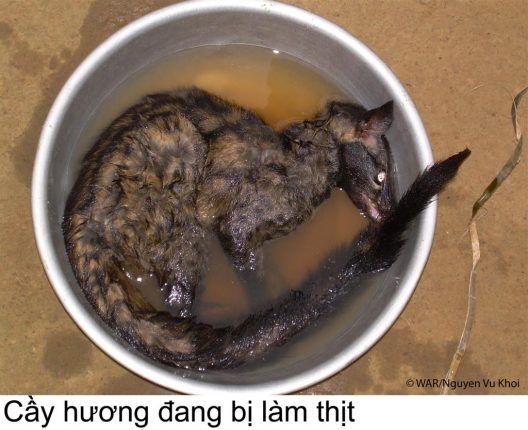
Ho Chi Minh City, 23 May 2011 – Wildlife At Risk (WAR) announces the latest findings on consumption of wild animal products in Ho Chi Minh City (HCMC). These findings are results of a survey, which was carried out on 4000 HCMC residents and nearly 3600 secondary school students in HCMC from August 2010 to April 2011. The survey was in cooperation between WAR and the Faculty of Biology, University of Science, Vietnam National University Ho Chi Minh City.
According to this survey, over halve of the surveyed residents who live and work in HCMC have used wild animal products, of which nearly 50% have consumed wild animal products more than three times per year. Men consume more wild animal products than women. Food accounts for the greatest percentage of wild animal products consumed in HCMC, followed in turn by wild animal drinks, health products, pets, and fashion and ornamental purpose. Restaurants in HCMC are the most common place for people to eat wild animal foods. The majority of HCMC people eat wild meat because others invite them, they want to try new experiences or they feel the meat is more delicious. Middle-aged group (36-45 years old), government officers, and people with high education levels have a tendency to consume wild animal products more than other age groups, people with lower social working position, and people with lower education level. The consumption of wild animal products of HCMC people seems to have a tendency to increase in the future.
The survey also shows that the consumption of wild animal products of secondary school students in HCMC was strongly influenced by their parents and adults in their families. However, only 28.2% of surveyed students in HCMC have consumed wild animal products. More male students consume wild animal products than female students. Among types of wild animal product consumed by students, food accounts for the greatest percentage of wild animal products consumed among the students. Most of the survey students eat wild meat because they want to try new experiences and feel the meat is tastier. Not like the adults, students usually go to eat wild meat with their parents in specialty restaurants in other provinces or during family events such as birthdays and family gatherings at home.
Results of the survey on knowledge and attitude of HCMC residents and students reveal that all of them have good knowledge about the roles of wild animals but they do not understand well about the rarity levels of small wild animals that are mainly consumed. They do not know clearly about wild animal trade. They think that trading of any wild species is illegal. They think that consumption of wild animal products is the most dangerous threat to wild species. In reality, wild animal product consumers are the force of illegal hunting and trading of wild animal products, helping push some wild animals to the brink of extinction. Most of residents and students could report to the correct offices when they find out illegal wild animal trade. However, most of them do not know and do not remember the correct telephone number to report crimes too. The surveyed students have a good attitude towards wild animal protection. They are also more willing to take part in wild animal protection than adults.
According to Dr. Huy Hoang Duc, Vice Deputy, Faculty of Biology, University of Science, Vietnam National University HCMC, “The survey helps us to understand the consumption of wild animal products in HCMC. This is a strong foundation to design effective conservation initiatives in order to prevent illegal wild animal trade and consumption.”
Based on results of this survey, WAR recommends that communication and education programs need to be designed and developed for both residents and students in order to prevent illegal wild animal consumption. WAR’s recommendation is also to research and introduce wild animal products from legal farming. In addition, enforcement and conservation research should be developed to contribute to wildlife protection, especially protection of threaten species.
Ms. Huyen Do Thi Thanh, Wildlife Education Manager, Wildlife At Risk confirms that: “Initiatives aims to prevent illegal wild animal trade should target the consumers because they are the force of illegal trading and hunting of wild animal products and thus pushing wild animals to the brink of extinction. Effective education programs for young generations will be a sustainable and long-term effective solution. These programmes will be a priority of WAR”
In the coming time, WAR will conduct various activities aiming to educate and encourage legal and sustainable consumption of wild animal products in order to prevent illegal wild animal consumption.
Please download the Press release here.

